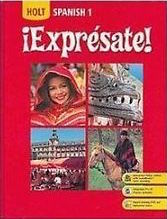
All Solutions
Page 336: Preparate para el examen
2. limpiaron (limpiar).
3. decoraron (decorar).
4. fuimos (ir).
5. pasaste (pasar).
6. fui (ir).
7. volvimos (volver).
8. abrió (abrir).
2. asientos/enviamos.
3. fiesta.
4. ponche.
5. aniversario.
6. parte.
2. conozco.
3. me.
4. te.
5. están.
6. estamos.
7. nos.
El carnaval es una celebración típica que toma lugar en distintos meses del año dependiendo del país. Durante los carnavales se pueden ver grandes cantidades de personas disfrazadas o usando trajes folclóricos. Se coordinan desfiles y hay mucha música y baile. (*Carnival is a typical celebration that takes place in different months of the year depending on the country. During carnivals, you can see large numbers of people dressed up or wearing folk costumes. Parades are coordinated and there is a lot of music and dancing.*)
Los pasteles en hoja son típicos de la cocina en la República Dominicana. Se hacen a base de una masa de plátano u otros tubérculos y tiene un cierto parecido al tradicional tamal colombiano y a la hallaca venezolana. Se acostumbra consumirlo en épocas navideñas. (*Sheet cakes are typical of the kitchen in the Dominican Republic. They are made from a dough of banana or other tubers and have a certain resemblance to the traditional Colombian tamale and the Venezuelan Hallaca. It is customary to consume it at Christmas time.*)
Los quince años son celebrados en la comunidad hispana como parte de un ritual de transformación femenina de la infancia a la adultez. Se acostumbra a celebrar con una gran fiesta. A la quinceañera se le regala un vestido de su preferencia y se hacen varios rituales para que el fenómeno quede asentado como un evento único e irrepetible, como el cambio de zapatos planos a zapatos de tacón. La celebración de los dulces diesiceis en norteamérica se asemeja mucho a los quince años.

